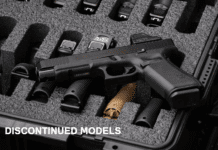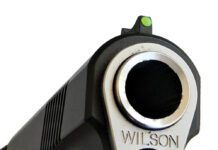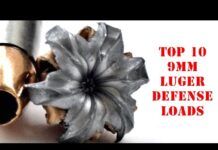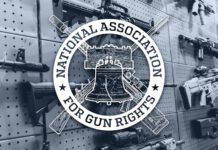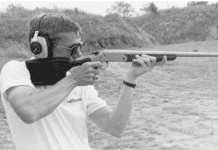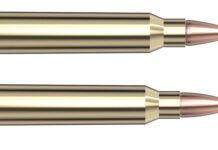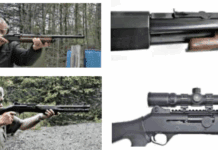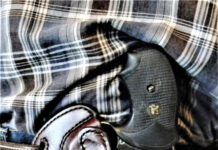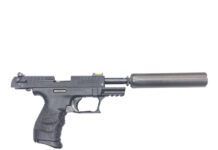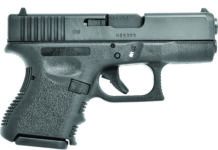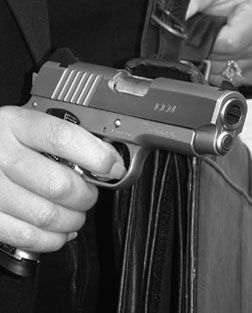
A lot of shooters still like a small, concealable .45, but they wonder about simplicity in operation: i.e., should they stick with the tried-and-true single-action 1911 cocked-and-locked formula, or go to a double-action trigger? In this test we will look at two competing ways to conceal and deliver the .45 ACP using a smaller-sized handgun, and also see how two new guns stack up against a previously tested gun of similar size and operation.
Our fresh test products were the Springfield Armory Micro Compact LW Bi-Tone Operator, a traditional single-action 1911 greatly reduced in size from a full-size gun, $1,247. The second gun was a Para Ordnance CCO CWX745S, $1,049, a full-time double action.
We collected using a 15-yard sandbag rest, but we also tried rapid repeat fire to gauge how the guns would work straight out of the holster, looking in particular at how the difference in the triggers would affect accuracy, rapid fire capability, and safety. To test the guns, we shot self-defense loads from Winchester (185-grain FMJ and 230-grain SXT JHP rounds) and 200-grain TAP FPD hollowpoints from Hornady.
Also, we evaluated these products from a historical perspective, gauging how they fared against a top-ranked gun we’ve already tested and liked. If the new guns offer performance equal to or better than what we’ve already seen, then they’ll get our nod here. If not, we’ll tell you what guns are better buys, and why.
Here’s what we found:
[PDFCAP(2)]
The Para Ordnance CCO is the Companion Carry Option pistol in the LDA (light double action) PXT series of smaller .45s from this Canadian manufacturer. This Toronto-based firm pioneered high-capacity .45s by adapting a wide-body receiver that could accept double-stack or staggered-column magazines.
The LDA trigger system is a full-time double-action trigger that presents some operational choices atypical of the 1911. For one, to rack the slide or move it to the rear in preparation for loading or field stripping, the beavertail must be pressed in. With top end removed, we saw that the recoil assembly consisted of a plunger and two springs. The inner rod appeared spindly to us, as did the thin-walled stop at the rear that pushed against the feet of the barrel. Another part that looked underbuilt was the transfer bar that connected the trigger to the hammer. Despite our concerns, we encountered no malfunctions or breakdowns during our test.
At the range we were able to discern several characteristics of the LDA trigger system that separate it from single-action operation. Unlike most DAO pistols, the CCO benefited from having a thumb safety as well as a grip safety. The face of the trigger itself was finished with a smooth rounded profile to prevent the trigger finger from dragging during a press. Once a round was chambered, the hammer would show only slightly out of its flush resting position. The hammer lacked a spur to avoid a possible snag and to discourage thumbing back the hammer, which reportedly can damage the LDA system.
During the trigger press, we saw the hammer moving back, and to cancel a shot, the shooter simply stopped squeezing the trigger. Once a round was chambered, the trigger needed to be pressed about 0.33 inch before DA movement was completely taken up. Once the movement had been taken up, the final resistance was soft and smooth.
Elsewhere, the CCO was an all-stainless-steel pistol with black anodized mainspring housing that was flat in profile and sported 20-lpi checkering. The frontstrap was treated to a ribbed pattern that Para calls Griptor ribs. Seven-round magazines with a lipped basepad completed the frontstrap. The grip panels were also a proprietary product, not wood but a handsome product called Para Laminate. The slide offered wide cocking grooves on the rear only, and the sights were Para’s three-dot non-snag product dovetailed front and rear. The profile of the rear sight was lined and rounded off. We think that some rounded-off sight blades make alignment difficult, but the CCO’s front blade sat in the rear notch like the last piece of a puzzle.
The bull barrel was supported at the front by a bushing that fit into the underlug of the slide. This bushing was also where the recoil spring assembly was captured. Combined with the weight of this pistol and the way it fit our hands, the result of this arrangement was a very comfortable gun to shoot, even with stout personal-defense loads. The Griptor ribs looked good to us, but we felt their contribution to comfort and control was subtle at best.
Still, we found the CCO very easy to shoot accurately from the bench. The Winchester 185-grain FMJ rounds provided the best results. One five-shot string resulted in a single hole that we measured to be about 0.33 inch wide. Overall average firing this round was 1.1 inches per five- shot group. Five shots of the Hornady rounds averaged 1.7 inches, and we shot 2.0-inch groups on average with the Winchester SXT ammunition.
In terms of speed, we concluded that the Para Ordnance LDA system was a little slower overall than the Springfield pistol that utilized a sliding trigger. The shorter slide movement of the Springfield may also have contributed, but we think that the longer movement of the LDA trigger meant that in terms of reset, it just couldn’t keep up with what was essentially a match trigger on the Springfield. However, we found that even less experienced shooters with little or no match experience were smoother from shot to shot with the Para Ordnance.
Carrying the gun day to day, we liked the Para Ordnance’s slim profile and snag-free design. However, its weight was hard to ignore. Also, we couldn’t find eight-round magazines for this pistol, and that’s a shame. With 8+1 rounds, putting its capacity in league with full-sized 1911s, the Para Ordnance CCO would be a tough pistol to pass up.
[PDFCAP(3)]
The LW Bi-Tone Operator was a jewel of a little 1911 single-action pistol. Slimline cocobolo grips with glasslike finish adorned its forged aluminum hard-coat-anodized frame. The underlug featured a Picatinny rail, and the magazine well was treated to an effective bevel job. The supplied six-round magazines (and the seven- and eight-round aftermarket magazines we tried from Wilson Combat) had little problem sliding right into the gun. Other features included ambidextrous thumb safeties, memory groove grip safety, a relieved trigger adjustable for overtravel, relieved hammer, Novak night sights, matte blue frame, and stainless matte slide. This was a difficult gun to dislike.
With the top end removed, we saw that the Springfield shared the design of its recoil assembly with the Para Ordnance CCO, but we thought the Springfield Armory version, which is called the Captive Dual Recoil Assembly, looked sturdier. The smaller size of the Springfield did not seem to make it more vulnerable to recoil. On the hip, the LW Bi-Tone Operator was an easy carry, and we think it is a natural for other forms of covert carry such as in a glove box or briefcase.
We spent much of our time with both guns shooting the Winchester 185-grain FMJ rounds. Priced at about $14 for a box of 50 rounds, we have found it to be one of the most accurate and soft-shooting .45 rounds on the market. From the bench, group sizes varied from 1.2 to 1.9 inches. Shooting the 200-grain Hornady TAP FPD rounds, distinguishable by their anodized cases, the Springfield edged out the Para Ordnance, with groups varying in size from 1.4 to 1.7 inches. With each of these rounds the Springfield cycled willingly and quickly.
But our experience with the 230-grain rounds proved to be not as accurate or as reliable. Our five-shot groups with the Winchester SXT ammunition was in the 2.5-inch range, but we were distracted by stoppages wherein the first round from a fully loaded magazine would not climb the ramp into the chamber. This also happened with the last round in the magazine on some occasions.
Looking closely at these stoppages, we noticed that the 185-grain Winchester ammunition that worked so well showed much less bullet above the case mouth and had a tapered profile when compared to the Winchester SXT rounds. So, it’s likely that bullet profile and how bullets hit the feed ramp may have played a part in the malfunctions. We tried using different types of magazines to no avail and even ruled out bullet weight after the little gun fed 100 rounds of 230-grain Winchester FMJ rounds without malfunction.
We went on to fire odd lots of ammunition, including Federal 165-grain JHP rounds as well as 90-grain Total Fragmenting Soft Point ammunition from RCBD. In each case the Springfield was a willing participant. But our shots of record show that the Springfield was fussier than the Para Ordnance CCO, which in a self-defense gun, is enough to rule it out.
Other Options:
Taurus Millennium Pro PT 745C .45 ACP, $484
This all-matte-black pistol (June 2005) offered a slim, comfortable grip concealing a single-stack magazine of 6+1 shots. The double-action pistol was striker fired, and the long trigger pull broke just before it touched the frame at the very back of the trigger guard. This trigger required some learning time.
The Taurus measured 6.0 inches in overall length, with a 3.2-inch barrel. Overall height was 5.0 inches, and the gun weighed 22.4 ounces unloaded. The frame was black polymer, sitting beneath a matte-blued steel slide. Trigger pull weight double action measured 8.0 pounds.
Each pull of the trigger dropped the striker. There was a safety lever, easily operated by the right thumb, that blocked the trigger. Overall fit and finish of the Millennium Pro was excellent. On the range we found no problems with this Taurus. We tested with Hungarian MFS ball (2.4-inch group average), a handload with 200-grain cast SWCs (1.3-inch group average), and Cor-Bon’s 185-grain JHP (1.5-inch group average). Everything fed, fired, and ejected perfectly.
Gun Tests Recommends
• Para Ordnance CCO CWX745S .45 ACP, $1049. Don’t Buy. Though accurate, easy to shoot, slim, and snag free, the CCO was not as light as it looked, and we’d like to see it fitted with eight-round magazines just like a full-size pistol. The Taurus Pro PT 745C .45 ACP is lighter and smaller and costs substantially less money, so we’re hard-pressed to recommend the CCO. However, many shooters might consider the CCO a Conditional Buy or even a Buy It if they want a metal-frame gun instead of polymer.
• Springfield Armory Micro Compact LW Bi-Tone Operator .45 ACP, $1247. Don’t Buy. This was a beautifully made little package, but it balked when shooting one of our test ammos in the popular 230-grain weight. Shooters who are willing to experiment with ammo brands might upgrade this recommendation to a Conditional Buy, but for our money, we’ll instead take the gun that just goes bang for hundreds less.
• Taurus Millennium Pro PT 745C .45 ACP, $484. Still Our Pick. We were favorably impressed with this pistol as far back as June 2005, and further data collection hasn’t swayed us from that view. The DA 8-pound trigger was controllable and consistent, and at 15 yards, it shot on par with the more expensive guns tested above.



